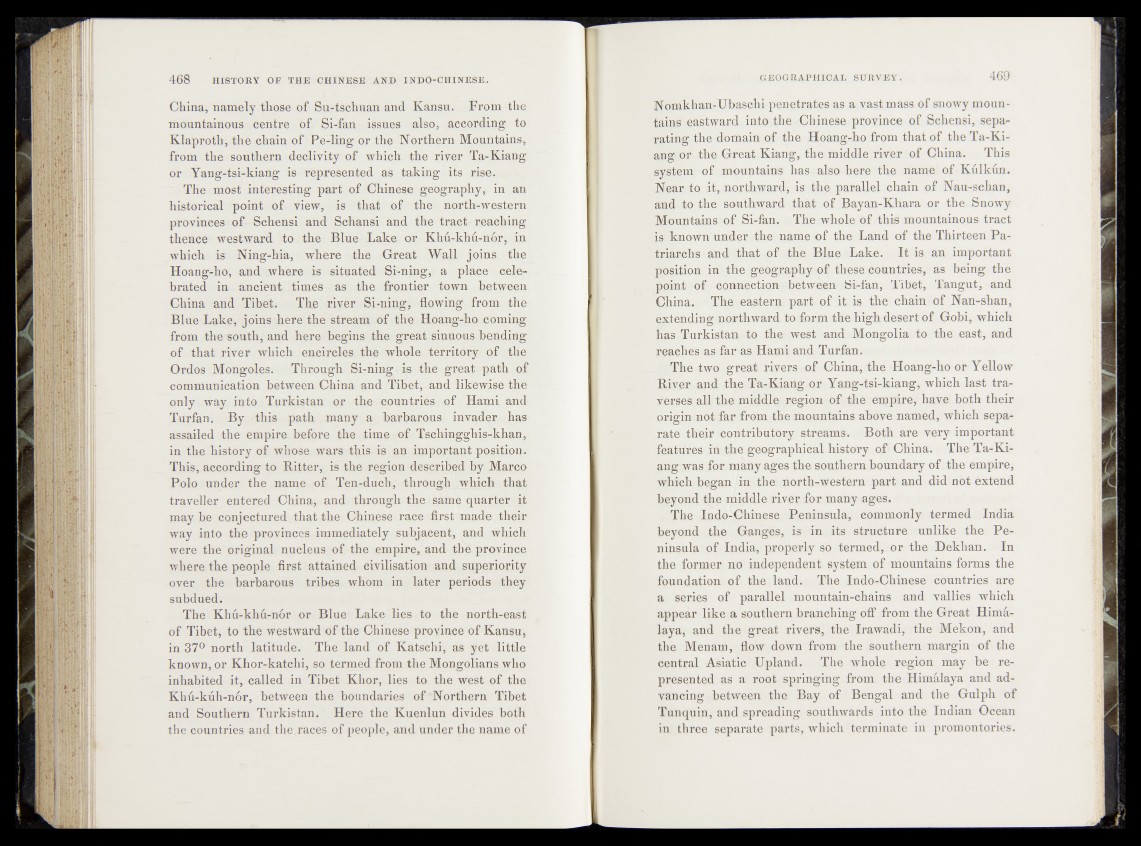
China, namely those of Su-tschuan and Kansu. From the
mountainous centre of: Si-fan issues also, according* to
Klaproth, the chain of Pe-ling or the Northern Mountains,
from the southern declivity of which the river Ta-Kiang
or Yang-tsi-kiang is represented as taking its rise.
The most interesting part of Chinese geography, in an
historical point of view, is that of the: north-western
provinces of Schensi and. Schansi and the tract reaching
thence westward to the Blue Lake or Khu-khu-n6r, in
which i s , Ning-hia, where the Great Wall joins the
Hoang-ho, and where is situated Si-ning, a place cele^
brated in ancient times as the frontier town between
China and Tibet. The river Si-ning, flowing from the
Blue Lake, joins here the stream of the Hoang-ho coming
from the south, and here begins the great sinuous bending
of that river which encircles the whole territory of the
Ordos Mongoles. Through Si-ning is the great path of
communication between China and Tibet, and likewise the
only way into Turkistan or the countries of Hami and
Turfan. By this path many a barbarous invader has
assailed the empire before the time of Tschingghis-khan,
in the history of whose wars this is an important position.
This, according to Ritter, is the region described by Marco
Polo under the name of Ten-dueb, through , whjch that
traveller entered China, and through the same quarter it
may be conjectured that the Chinese race first made their
way into the provinces immediately subjacent, and which
were the original nucleus of the empire, and the province
where the people first attained civilisation and superiority
over the barbarous tribes whom in later periods they
subdued.
The Khu-khu-n6r or Blue Lake lies to the north-east
of Tibet, to the westward of the Chinese province of Kansu,
in 37° north latitude. The land of Katsehi, as yet little
known, or Khor-katchi, so termed from the Mongolians who
inhabited it, called in Tibet Khor, lies to the west of the
Khu-kuh-n6r, between the boundaries o f‘Northern Tibet
and Southern Turkistan.' Here the Kuenlun divides both
the countries and the.races of people, and under the name of
Nomkh an-Ubasc-bi penetrates as a vast mass of snowy mountains
eastward into the Chinese province of Schensi, separating
the domain of > the Hoang-ho from that of the Ta-Kiang
or- the Great Kiang, the middle river of China. This
system of mountains has also here the name of Kulkfin.
Near to -it, northward., i£ the parallel chain of Nau-schan,
and to the southward that of Bayan-Khara or the Snowy
Mountains of Si-fan, The whole of this mountainous tract
is known under the name of the Land of the Thirteen Patriarchs
and that of the Blue Lake, It is an important
position incth^geography of these countries, as being the
point of eonnection*between Si-fan, Tibet, Tangut, and
China. • The eastern part of it is. the chain of Nan-shan,
extending northward to form the high desert of Gobi, which
has Turkistan «to the: west and Mongolia to the east, and
reaches as far as Hami and Turfan.
The two great rivers of China, the Iloang-ho or Yellow
River and the Ta-Kiang or Yang-tsi-kiang, which last traverses
all the middle: region of tthe empire, have bbth their
origin.not far from the mountains above named, which separate
their ..contributory streams. Both are very-important
features in the geographical history of: China. The Ta-Ki-
ang was for ipany ages the southern boundary of tbe empire,
which began /'in the north-western part and did not extend
beyond the middle river for many ages.
The Indo-Chinese Peninsula, commonly termed India
beyond fcho Ganges, is in its structure unlike the Peninsula
of India, properly sp termed, or the Dekhan. In
the former no independent system of mountains forms the
foundatiop. of the land. The Indo-Chinese countries are
a series of parallel mountain-chains and vallies which
appear like a southern branching off from the Great Himalaya,
and the great rivers, the Irawadi, the Mekong and
the Menam, flow down from the Southern margin of the
central Asiatic Upland, The whole region may be re-*
presented as a root springing from the Himalaya and advancing
between the Bay of Bengal and the Gulph of
Tunquin, and spreading southwards into the Indian Ocean
in three separate parts, which terminate in promontories.